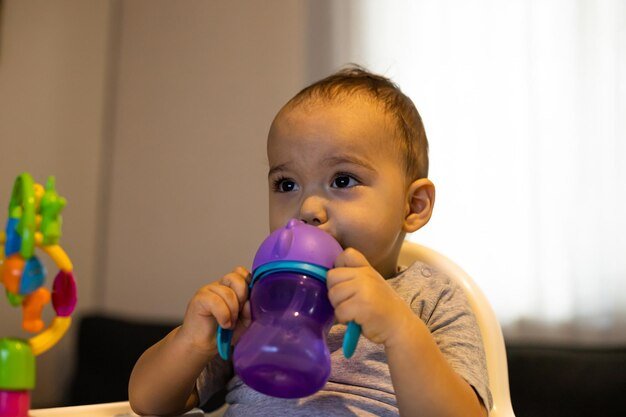When and How Much My Baby Can Have Water Intake?
 Babies do not require water till 6months of age. Why?
Babies do not require water till 6months of age. Why?
Breast milk contains 80% water provides fluid to your baby needs. Children who are bottle-fed will stay hydrated with the help of their formula.
What can happen?Giving your baby water before 6 months can cause:
1) Water feedings tend to fill up your baby, making them less interested in nursing. This could actually contribute to weight loss and elevated bilirubin levels.
2) Providing water to your newborn could result in water intoxication, which can dilute the other nutrient levels in the baby’s body.
3) Too much water causes their kidneys to flush out electrolytes, including sodium, leading to imbalances.
When and how to start?Babies ages 6 to 12 months
Child requires 60 to 120 ml of water in a 24 hour period.
Introduce water to the baby through a sipper cup.
Children 12 months and older
Once your child is 12-months old, their milk intake will reduce, ideally to a maximum of 16 ounces per day. At this stage, you may have established a routine involving breakfast, lunch, and dinner, while introducing a variety of new foods. Due to the increased activity of your child, the reduced milk intake, and the varied food intake, water intake will naturally increase. A1-year-old gets approximately one 8-ounce cup (230ml) of water every day. This amount increases each year. The number of 8-ounce cups an older child consumes each day should correspond with their age (up to a maximum of eight 8-ounce cups per day). For example, a two-year-old should consume two 8-ounce (500ml/year increase) cups per day. Till your child grown into an adult, a maximum of 8 glasses per day is recommended. Staying hydrated can help your child have proper bowel movements and replenish any lost fluids.
to ensure adequate hydration?For most children, all you need to do is provide frequent access to water and they will drink enough to meet their needs. If you seem to have trouble encouraging your child to consume water through a sippy cup, try these additional tips to ensure adequate hydration.
Encourage small, frequent sips. Offer small amounts of water throughout the day. Your child will be hydrated but not full from other fluids, which may affect their meal intake.If you use diluted fruit juice, limit their intake to 4 ounces (115ml) of pure juice per day.
Make fluids fun
Young kids seem to be intrigued by colors and shapes. You could use colorful cups and fun-shaped straws so that your little ones are excited about consuming water.
Buy: Shop for cups and straws.
Be mindful of weather and activity
Kids aren’t able to regulate their body temperature as easily as adults, so it’s harder for them to recover and cool off. Encourage fluid intake before, during, and after activities.As a guideline, encourage at least 4 ounces of fluid every 20 minutes, or whenever a break happens.
An ounce of water is equal to about one “gulp” from your little one.
Incorporate water-rich foods
Foods such as soups or fruits such as watermelon, oranges, and grapes are rich in water. You can also flavor water with lemon, lime, cucumber, or oranges to make it fun and tasty.
TAKEAWAY MESSAGEYour baby may be ready to take their first sip of water at six months. However, it’s important to realize that newborns, infants, and toddlers have very different hydration from adults. What we’d expect ourselves to do in hot weather or during activity is quite different from what they would be encouraged to do. As long as you pay attention to your child’s activity and give them plenty of access to water after age 1, you’ll make appropriate decisions.
